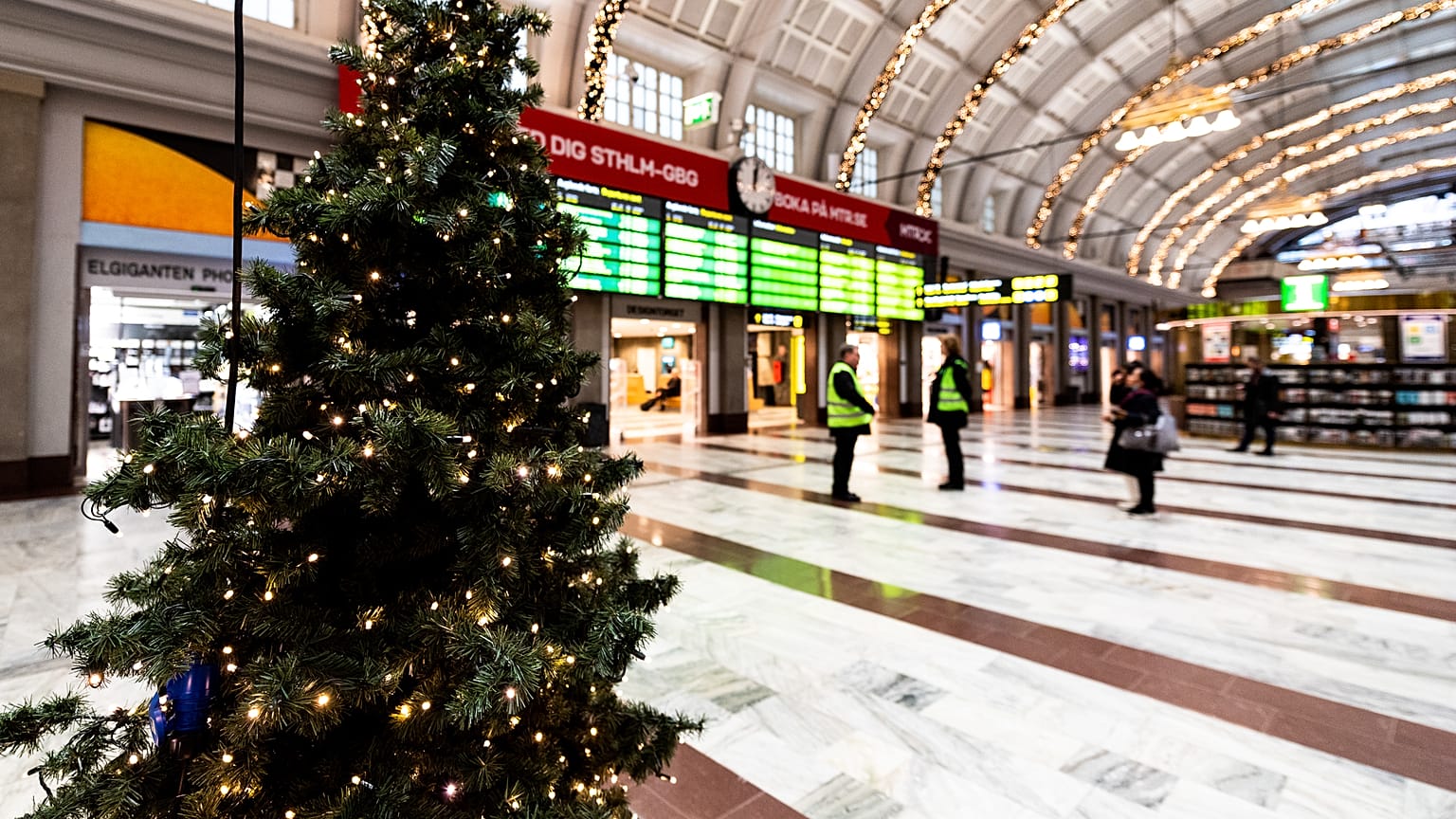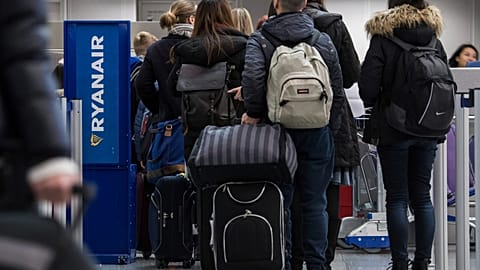Here's what we currently know, country-by-country.
This article has been updated.
**After a brief reopening of European borders in the summer months, many countries across Europe have closed their borders again.
The second wave of COVID-19 infections, as well as a new variant of the virus taking hold in the UK, has countries implementing lockdown measures over the winter holiday season and restricting travel across borders. **
European Union countries have agreed on a coordinated approach on travel restrictions, including a "traffic lights" colour code for regions on the basis of risks linked to COVID-19.
The European Centre for Disease Prevention and Control has published maps to support a coordinated approach across the bloc. It's updated every Thursday.
For countries outside of the bloc, the EU has recommended opening external borders to a select group, based on their coronavirus numbers.
According to its updated list as of December 17, the European Council advises member states to gradually lift travel restrictions at external borders from residents of nine non-EU countries: Australia, Japan, New Zealand, Rwanda, Singapore, South Korea, Thailand, and China (including Hong Kong and Macao). In China's case, it is subject to reciprocity.
**The December update saw Uruguay removed from the list, joining others such as Canada, Georgia, Tunisia, the United States, Montenegro, Morocco and Serbia -- all countries the EU advises should be subject to travel restrictions. **
Member states are not, however, legally obliged to follow the EU's recommendation.
Below is Euronews' at-a-glance look at the situation in each European country regarding incoming travel. It does not include details of internal coronavirus restrictions including lockdowns within their own borders, or of any conditions applied to people returning to their home nations.
In many cases authorised travel also expressly extends to family members and transit passengers. It should be noted that some countries have also imposed travel restrictions on their own residents leaving their territories.
Albania
Albania reopened its borders to all travellers, including all EU nationals and residents, on June 1. **However, as of December 22, all flights to and from Great Britain have been suspended until January 6, 2021. Health screening procedures are in place at airports and other ports of entry, but there are no quarantine restrictions, nor is a negative PCR-test required to enter. **
Commercial flights resumed on June 15. From other European countries, Albania can be reached with flights from Germany, Italy, the UK, Serbia, Austria, Greece and Turkey.
Austria
Austria's borders are open but for essential travel only during a lockdown period that will last at least until January 17.
**Flights from the UK aren't allowed to land in Austria from December 22 until January 1, 2021. **
**Quarantine rules are in effect from anyone coming from a risk area, which at this point is everywhere except Australia, Finland, Ireland, Japan, New Zealand, Norway, South Korea, Uruguay, and the Vatican.
If you are coming from a risk area, you must submit a "Declaration of Quarantine" form upon arrival. At the earliest, 5 days after arrival, may travellers in quarantine take a PCR or antigen COVID test to shorten the quarantine. **
The quarantine rules do not apply to passengers in transit.
Full information is available here.
Belgium
Non-essential travel to Belgium is banned, but this does not apply to nationals and residents of EU and Schengen member states. Exemptions are also made for travellers from non-Schengen EU countries (Ireland, Romania, Bulgaria, Croatia and Cyprus) and the UK (until it leaves the EU at midnight on December 31).
Beyond Europe, Belgium allows incomers without restrictions for people living in eight countries from the EU's "safe list".
**Starting December 25, any traveller older than 12 who is arriving from a red zone as indicated on the Federal Public Service Foreign Affairs website, must present a negative COVID-19 test, which has to have been carried out 48 hours before arrival in Belgium. **
Belgium's immigration office has more details.
Bosnia and Herzegovina
Foreign nationals need to provide a negative coronavirus test not older than 48 hours in order to enter the country.
Bosnian nationals, as well as citizens of Montenegro, Croatia and Serbia, do not have to provide a negative test. **Neither do foreigners transiting through the territory to get to their country of residence, and foreign spouses of citizens of Bosnia and Herzegovina. **
The country's border police website has more.
Bulgaria
Entry is open for Bulgarian nationals, as well as citizens of EU, UK and Schengen area countries, along with family members.
From 5 pm local time on Sunday 20 December, all those arriving in Bulgaria from the UK, regardless of nationality, are required to self-isolate for 10 days from the date of arrival. The measure is currently scheduled to be in place until 31 January 2021.
Citizens from a list of more than 20 other countries are also allowed into the country, subject to a negative PCR test. The United States is not on the list.
Anyone entering Bulgaria, who is not included in any exemption is required to present a negative PCR test done 72 hours before entry.
There are other exemptions from entry restrictions. See the Bulgarian Foreign Ministry website.
Croatia
Citizens of EU member states and Schengen Associated countries can enter without restrictions as long as they are coming directly from EU/EE**A member states or regions that are on the European Centre for Disease Prevention and Control's Green List. **
**If they're coming from EU/EEA states or regions not on that list, they must present a negative PCR test result that is not older than 48 hours. So do EU citizens, residents and family members coming from third countries. **
**Without a test, individuals are subject to a mandatory 14-day quarantine. **
Cyprus
Cyprus has a three-tier system for entry into the country. The list dated November 6 is updated frequently:
List A — "Low-risk countries" (no restrictions): Australia, Japan, New Zealand, South Korea, Singapore, Thailand.
List B — "Possibly low risk but greater uncertainty" (entry permitted with negative COVID-19 test): 8 EU countries as well as the UK, Norway and some other countries.
List C — "High-risk countries" (must have a negative test or undergo one): 18 remaining EU countries, plus some others including Schengen members Switzerland, Iceland and Lichtenstein.
The weekly ECDC evaluation will be the basis for the categorization.
Czech Republic
On 21 October the government banned free movement into the country apart from for essential reasons: work or business, essential family travel, for healthcare or other listed purposes.
The government updated its list on November 5 of countries from which travellers may be subject to additional restrictions under a red-orange-green "traffic light" system, to take effect from November 9.
Entry is prohibited to all other third-country nationals, except for listed exceptions.
Denmark
Denmark’s borders have been closing again to many European countries, but this is subject to change based on a set of health measures and analysis. The list of countries declared open or high-risk is updated weekly.
Among European countries, the map applicable until November 20 shows Finland to be open.
But many parts of Sweden and much of Norway are on the high-risk list, as are most EU nations and the UK. In order to enter, travellers must have a valid reason as well as a certificate proving a negative test taken no more than 72 hours prior to arrival.
Countries in the rest of the world declared open are as follows: Australia, Japan, New Zealand, Singapore, South Korea, Thailand and Uruguay.
Estonia
Details of travel rules into Estonia are available on the foreign ministry website. Since September the country had been reopening its borders, but a list published in early November details restrictions on travellers from numerous countries in Europe, due to rising virus infections.
If they come from a country with an infection rate above 50 per 100,000 population, a 10-day restriction on movement will be imposed. The list is reviewed weekly.
For travellers from outside Europe, Estonia allows entries from several countries in line with EU recommendations.
Finland
The Finnish Border Guard has published new information regarding incoming travellers valid from November 9.
It puts countries into different categories. Those where border controls are returning to normal include those on the EU's list of recommended open countries. Entries under "category 1" restrictions include most European countries, limited mainly to work related or essential travel. "Category 2" countries include Russia, Turkey and the United States and restrictions limit entries to essential travel.
Prior coronavirus testing becomes mandatory from November 23 from high-incidence countries.
Finnish nationals, residents and their families are free to enter the country, as can EU and Schengen transit passengers.
France
Travellers from EU member states and several other countries -- including the UK, Norway, Switzerland, Australia, Iceland, Japan and New Zealand can enter France without restrictions.
All travellers must however present a travel certificate stating their reasons for travel and a sworn statement to say they are not showing signs of COVID-19 infection. Details are available on the French Ministry of Interior and French foreign ministry websites.
Passengers arriving from several other countries may have to present a negative test result carried out less than 72 hours before boarding. The list of countries is expanded as of November 11. People coming from French overseas territories will need to take a test.
Germany
In principle, entry into Germany is possible from EU and Schengen countries, as well as the UK and several other countries around the world on the EU-approved list.
Entry from other countries is only allowed in exceptional cases and if there is an urgent need.
People coming from countries deemed to be risk areas must pre-register online. A federal list of risk countries effective from November 8 has added Denmark, Italy, Estonia, Greece, Latvia, Lithuania, Norway, Portugal and Sweden.
More details are available on the German interior ministry website.
Greece
Residents of EU countries are allowed to enter Greece, as well as those from the United Kingdom, Switzerland, Norway, Lichtenstein and Iceland.
So can residents from the EU-approved list of other countries, as well as arrivals from the UAE in November subject to conditions.
As of November 11, all travellers arriving in Greece from foreign countries are required to have a negative virus test result, carried out under 72 hours before arrival. This also applies to Greek citizens and residents.
Test certificates must be from authorised centres and written in English. Updated information on Greece's restrictions is available here.
Hungary
Hungary closed its borders to foreigners from September 1 although there are exemptions for residents and other categories of people coming for limited, specific purposes.
Restrictions were later amended for travellers coming from other Visegrad Group (V4) countries -- Czech Republic, Poland and Slovakia -- under certain conditions.
Iceland
Iceland's borders are open to citizens and residents of EU, Schengen and some other European countries, subject to pre-registration.
Restrictions are imposed on citizens of third countries. Further information is available here.
Ireland
From November 9, Ireland is applying the new EU "traffic light" approach to travel from EU and EEA countries, as well as the UK.
In general, people are asked to restrict movements upon arrival, unless they come from "green" countries, Northern Ireland, or form part of other defined categories.
By law, travellers must fill out a passenger locator form before arriving in Ireland.
Italy
An Italian government decree on measures to combat the coronavirus issued on November 3, and valid until December 3, includes international travel rules.
It identifies six groups of countries. Most EU countries are on list B, and are subject to no restrictions other than the need for passengers to fill out a self-declaration form.
Those arriving from List C countries -- Belgium, France, the Netherlands, the Czech Republic, Spain and the UK -- must present evidence of having taken a swab test with a negative result 72 hours prior to arriving in Italy or undergo one at the airport of entry or within 48 hours of arrival at a health clinic.
Beyond the EU-approved list of third countries, arrivals are restricted or banned.
Latvia
Latvia has also introduced a 10-day quarantine from travellers from high-risk countries. Its list updated on November 6 contains 34 European countries in this category.
People intending to work in areas such as health and education must self-isolate for 14 days.
Anyone intending to enter Latvia must complete an electronic form 48 hours before arriving in the country.
Latvia also implements EU recommendations allowing travel from a limited number of non-European countries.
Lithuania
On October 26 Lithuania began applying a "traffic light" system for arrivals into the Baltic country. It has published a list of affected countries and the ECDC's colour-coded map.
Citizens and residents of EEA countries (plus others including the UK and Switzerland) in red and grey areas are subject to coronavirus testing and a 10-day quarantine, with exceptions.
The entry of foreigners from outside the EEA is limited to exceptional cases, and subject to testing and self-isolation.
Luxembourg
Nationals of EU and Schengen Area associated countries are free to enter Luxembourg without producing a negative COVID-19 test. The same applies to UK citizens and those from San Marino, Andorra, Monaco and Vatican City.
Third-country nationals can no longer enter until December 31, 2020, apart from citizens from the EU-approved list of countries. More details are available here.
Malta
As of October 23 travellers arriving in Malta from its revised list of countries are obliged to provide a negative virus test dating from under 72 hours before arrival. Otherwise they may be subject to testing and quarantine in Malta.
The list as of November 10 has 14 countries, all of them in Europe apart from Tunisia.
The island nation operates a traffic light system (red, amber and green) with varying restrictions according to each level.
Other countries are categorised according to a traffic-light system for entries to the Mediterranean island.
Montenegro
Citizens and residents of Montenegro can enter the country, without restrictions if they had been in a "green list" country throughout the previous 15 days. Most European countries are on this list.
Citizens and residents of Montenegro coming from "yellow list" countries or who had passed through a yellow list country over the previous 15 days need to produce a negative PCR test or positive antibody test from the previous 72 hours before arrival. Those coming from countries not on these lists must self-isolate for 14 days.
Foreigners who are non-resident in Montenegro are subject to the same rules as above, but must have passport stamps proving their movements over the previous fortnight.
Full details are available on the government website.
The Netherlands
Borders are open but people are strongly advised not to travel to the Netherlands unless strictly necessary.
The government rules say nationals and residents of EU and Schengen countries as well as the UK can enter, but need to check whether they are from a list of countries which means they should self-quarantine for 10 days. As of November 10 the UK is on this list.
Citizens and residents of countries on the EU-approved list can also enter. For those coming from other countries, entry is restricted to listed exemptions -- which include nationals and residents of countries such as Norway and Switzerland.
Norway
The Norwegian government introduced stricter travel measures on November 5. Anyone arriving in the country must quarantine for 10 days unless they come from a specified European country with sufficiently low virus transmission.
As of November 10 the vast majority of European countries are designated as red areas, meaning visitors must present a recent negative virus test upon arrival and self-isolate.
Some parts of Finland are classed as yellow, meaning visitors do not need to quarantine.
Norway remains closed to arrivals from beyond Europe, with some exceptions for students and business travel, and routes are limited. The authorities advise against all non-essential international travel in recommendations valid until mid-January.
Poland
Poland restored full border traffic within the EU's internal borders from June 13. People can enter, exit and transit through the country without undergoing quarantine.
Borders with Russia, Belarus and Ukraine are only open at specific entry points.
From November 11, international flights from 10 listed countries are banned from entering Poland. The ban does not apply to countries ensuring that only passengers who tested negative for the virus would be taken on board.
Portugal
Flights to Portugal are allowed from EU and Schengen associated countries as well as the UK. Passengers do not need to present negative COVID-19 tests unless they are going to Madeira or the Azores.
Flights are also allowed from the EU-approved list of third countries, again with no need for passengers to present a negative test. Flights from other destinations are only permitted for essential travel and passengers must present a negative test.
Russia
Russia has partially opened up its borders since grounding most international flights and introducing entry restrictions for foreigners back in March.
Since then it has restored air travel with some countries -- including from Europe, Belarus, Serbia, Switzerland, Turkey and the UK. Approved countries outside Europe include South Korea, Japan and Cuba.
EU citizens living in the UK must have proof of UK residency. Foreigners from these countries are allowed to enter if they provide a negative virus test.
People from EU countries can only enter for authorised reasons such as work, family, transit or Russian residency.
Romania
Travellers from EU and Schengen associated countries can enter Romania, but currently many must quarantine for 14 days as they come from a "yellow list" of high-risk nations.
As of November 19 the list includes Austria, Belgium, Bulgaria, Czech Republic, France, Hungary, Italy, Luxembourg, Netherlands, Portugal, Spain, Switzerland, and the UK.
People are exempt from quarantine if coming for under three days and can present a negative virus test, or can leave quarantine if they test negative after eight days.
Otherwise, travellers from countries on the EU "safe list" can enter.
Serbia
Serbia's borders are open, and there are no quarantine restrictions unless visitors test positive during their trip.
Travellers from Croatia, Bulgaria, Romania and Northern Macedonia, however, are required to provide a PCR test to enter the country.
Slovakia
From November 16, government rules say people entering the country from abroad must provide a negative virus test taken within the previous 72 hours, or self-isolate for 10 days or until they present a negative test.
People from "low-risk" countries are exempt as long as they visited no other country in the previous 14 days. On the list as of mid-November are Australia, China, Finland, Greece, Iceland, Japan, New Zealand, Norway, South Korea and Taiwan.
Slovenia
Slovenia operates a colour-coded system with a green list representing those which are not subject to restrictions or quarantine. On the list as of November 16 are the EU-approved nations, minus China.
Anyone arriving from countries on the red list - of which many are European - must quarantine for 10 days unless they can provide evidence of a negative COVID-19 test not older than 48 hours.
The list as of November 16 contains 34 EU/Schengen, including neighbouring Croatia and Italy, and 116 third countries.
Spain
People from EU or Schengen countries can enter Spain, as can those on the EU-approved list of third countries. As of November 19 this includes China. All visitors have to undergo health checks on arrival.
However under the government rules, from November 23 all those from countries classed as "high-risk" must present a negative COVID-19 test dating from the previous 72 hours.
The list is reviewed every 15 days. As of November 19 it includes all or most regions from the EU's 27 countries, including neighbouring Portugal and France, as well as the UK, Norway and some three dozen third countries.
Sweden
Travel to Sweden from EU/EEA countries, the UK, Norway, Iceland, Liechtenstein and Switzerland, is permitted without the need for quarantine.
For other countries, the Swedish government has banned non-essential travel to the country until December 22. It does not apply to EU citizens or residents, or holders of a Swedish national visa.
Switzerland
Entry is open to Swiss nationals, residents, and those entitled to free movement -- covering those from EU and EFTA countries. Information for travellers is available on the federal health authority website.
People from non-Schengen countries, including the US, can only enter in exceptional cases. As of November 19 a list of exceptions to this ban covers 17 non-Schengen countries, including several in Europe.
Those who come from an updated list of high-risk countries must quarantine for 10 days.
Turkey
Turkey has opened its border to foreign travellers, except for the land border with Iran. Arrivals may have to go through health checks, including temperature checks.
If visitors test positive for coronavirus, they will have to quarantine.
UK
England requires people arriving from abroad to quarantine for 14 days on arrival, but in July created a system of "travel corridors" for countries deemed low-risk. The list which is regularly modified is available on the UK government website.
Arrivals from countries which are not on the travel corridor list will have to self-isolate for 14 days. This covers visitors from most EU nations, though the list of exemptions updated on November 14 included a handful of European countries including Estonia, Finland, Gibraltar, Ireland and Norway.
Travellers from the Channel Islands and the Isle of Man are also exempt, as are workers in some professions.
Wales, Scotland and Northern Ireland have introduced broadly the same rules as England but may differ slightly.


















